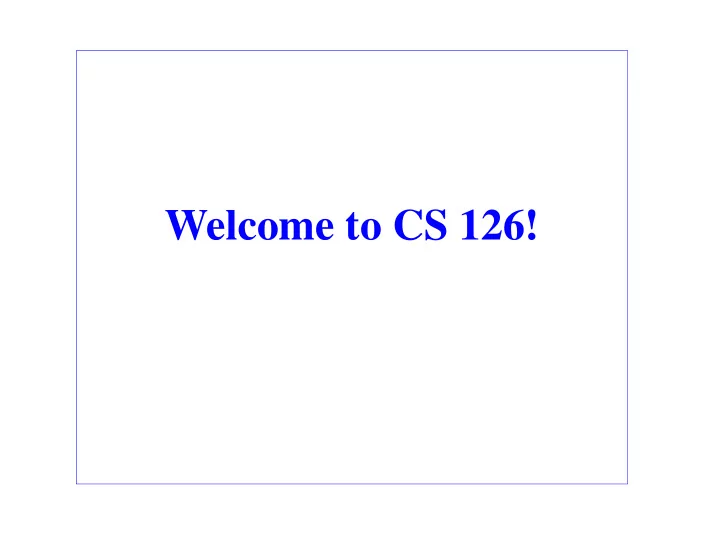

Welcome to CS 126!
Outline • Administrivia • What is “computer science”? - What it’s not - Why we learn it - Syllabus (long answer) • An example - A simple machine - “Science” behind it • Conclusion - CS is about abstractions (short answer) CS126 1-2 Randy Wang
The Usual Suspects • Randy Wang (rywang@cs) • Lisa Worthington (lworthin@cs) • Spyridon Triantafyllis (strianta@cs) • Jie Chen (jennifer@cs) • Petru Chebeleu (chebeleu@cs) • Ben Gum (gum@cs) • Alexey Lvov (lvov@math) CS126 1-3 Randy Wang
To Get Started • Visit course web page: - http://www.cs.princeton.edu/courses/cs126 • Get course packet from Pequod (ready by 9/22?): - for more general information • Go to lab tomorrow (9/17, 10-11:50, 1:30-3:30, CS101) - to get on-line • Decide which precept to go to - visit course page for preceptor assignment - contact tmhill@cs to make time changes • Go to precept on Monday (9/20) - to get remaining questions answered CS126 1-4 Randy Wang
Tips • “CS126 survival guide” • More... - Come to lectures and precepts - Do readings, exercises, as well as program assignments - Find a “system” that works best for you - Read, understand, and borrow from example code before writing your own CS126 1-6 Randy Wang
Outline • Administrivia • What is “computer science”? • An example • Conclusion CS126 1-7 Randy Wang
What Is CS? • (Why don’t we call chemistry “test tube science”?) • What CS is not - CS is not programming, just as - Biology is not about learning to use a microscope - Programming is merely a tool • Why we learn it - Appreciate underlying principles and limitations - “Meta-learning”: learning how to learn • What is it? - Syllabus (long answer) CS126 1-8 Randy Wang
Outline • Administrivia • What is “computer science”? • An example - How to make a simple machine - What we can do with it - “Science” behind it • Conclusion CS126 1-11 Randy Wang
A Simple Machine • Want - a machine that outputs a random sequence of 0s and 1s • Some basic terms - a bit: a student who’s either male or female - a storage element (cell): a seat that can hold one student - a register: a whole row of seats - a shift register: when clock strikes, stand up and take the seat to your right - a “linear feedback shift register”: ... CS126 1-12 Randy Wang
What Is It Good For? Message Encryption LFBSR LFBSR !@#$% Sam e Random R andom Bits Bits Message Message “+” “-” Encryption D ecryption M achine M achine • Use LFBSR as a component in an encryption/decryption machine • Cool detail: “+” and “-” can be xor; so same machines! CS126 1-15 Randy Wang
Now the “Science” Behind It • Are the bits really “random”? • How long would it take before the bit pattern repeat itself? • Will the machine work equally well if I xor the 10th and 4th bits? • How many cells do I need for my LFBSR if I want to guarantee a certain degree of security? CS126 1-17 Randy Wang
Outline • Administrivia • What is “computer science”? • An example • Conclusion - CS is about abstractions (short answer) CS126 1-19 Randy Wang
Abstractions Involving LFBSR ^ xor Cell R andom LFBSR B its E ncrypted C lear Encryption M essage Text E ncrypted C ustom er eShopping M essage O rders • Bigger boxes made of smaller ones, hide details behind interfaces • “Science” at each step for design decisions CS126 1-20 Randy Wang
Recommend
More recommend